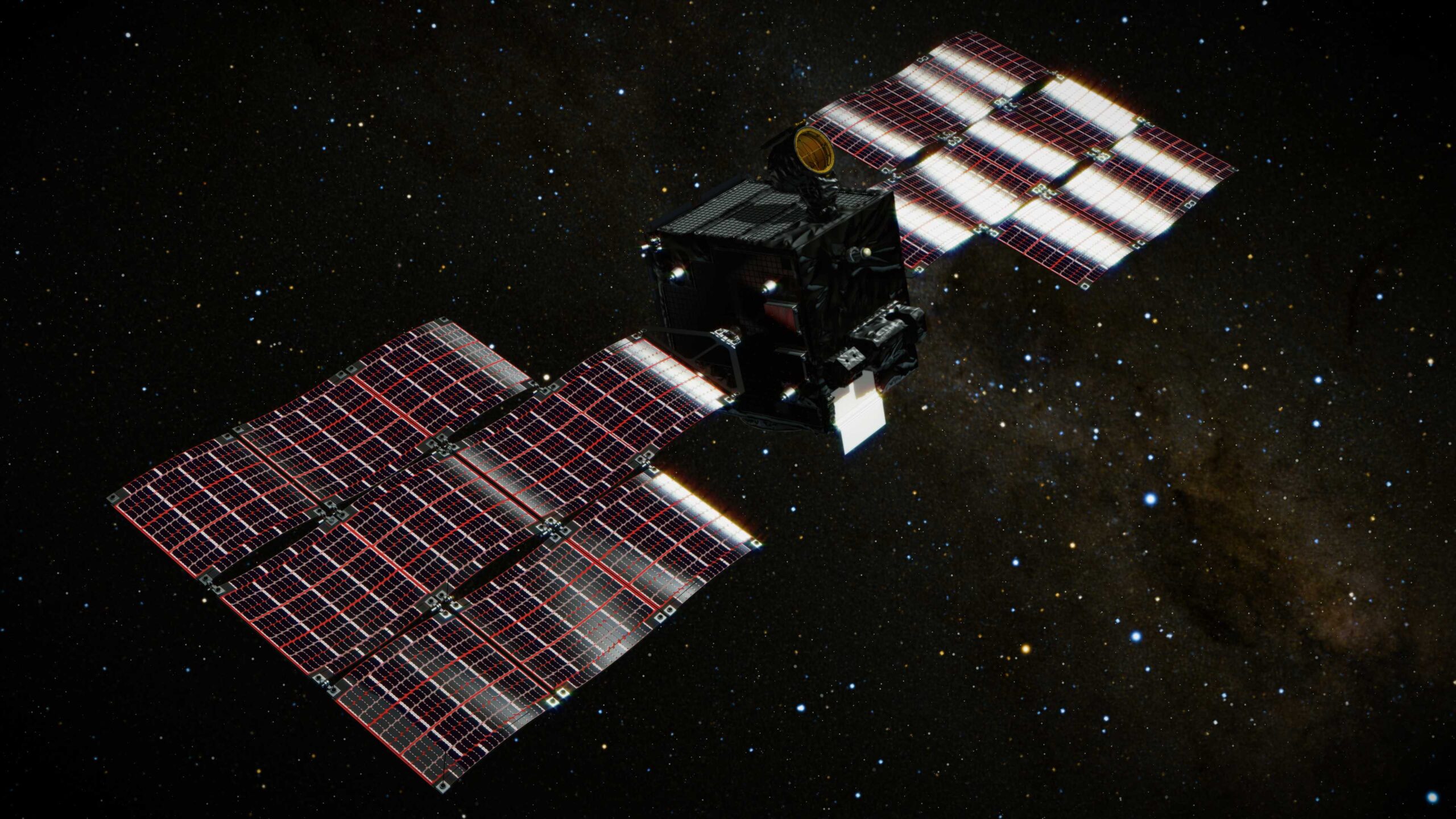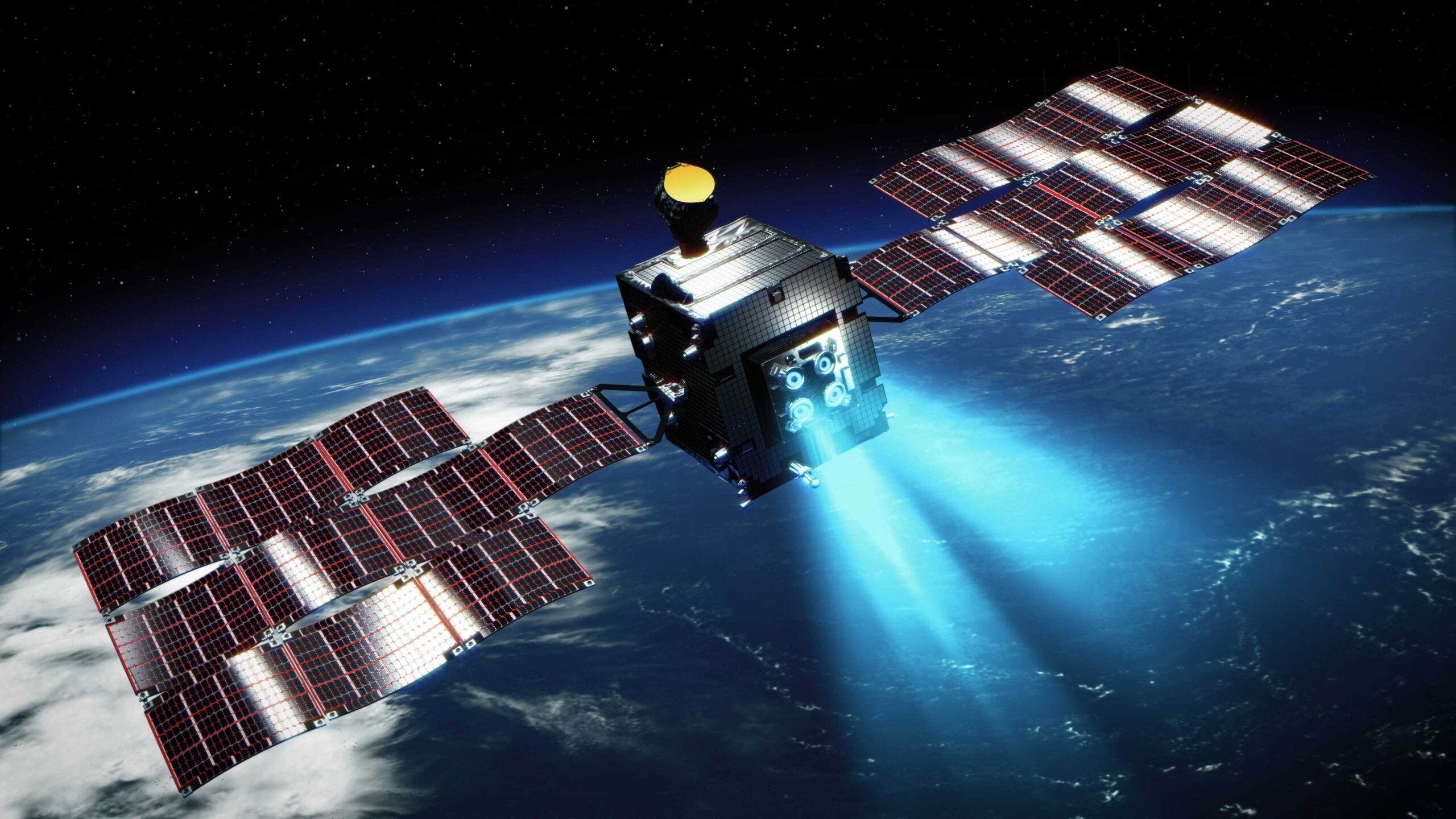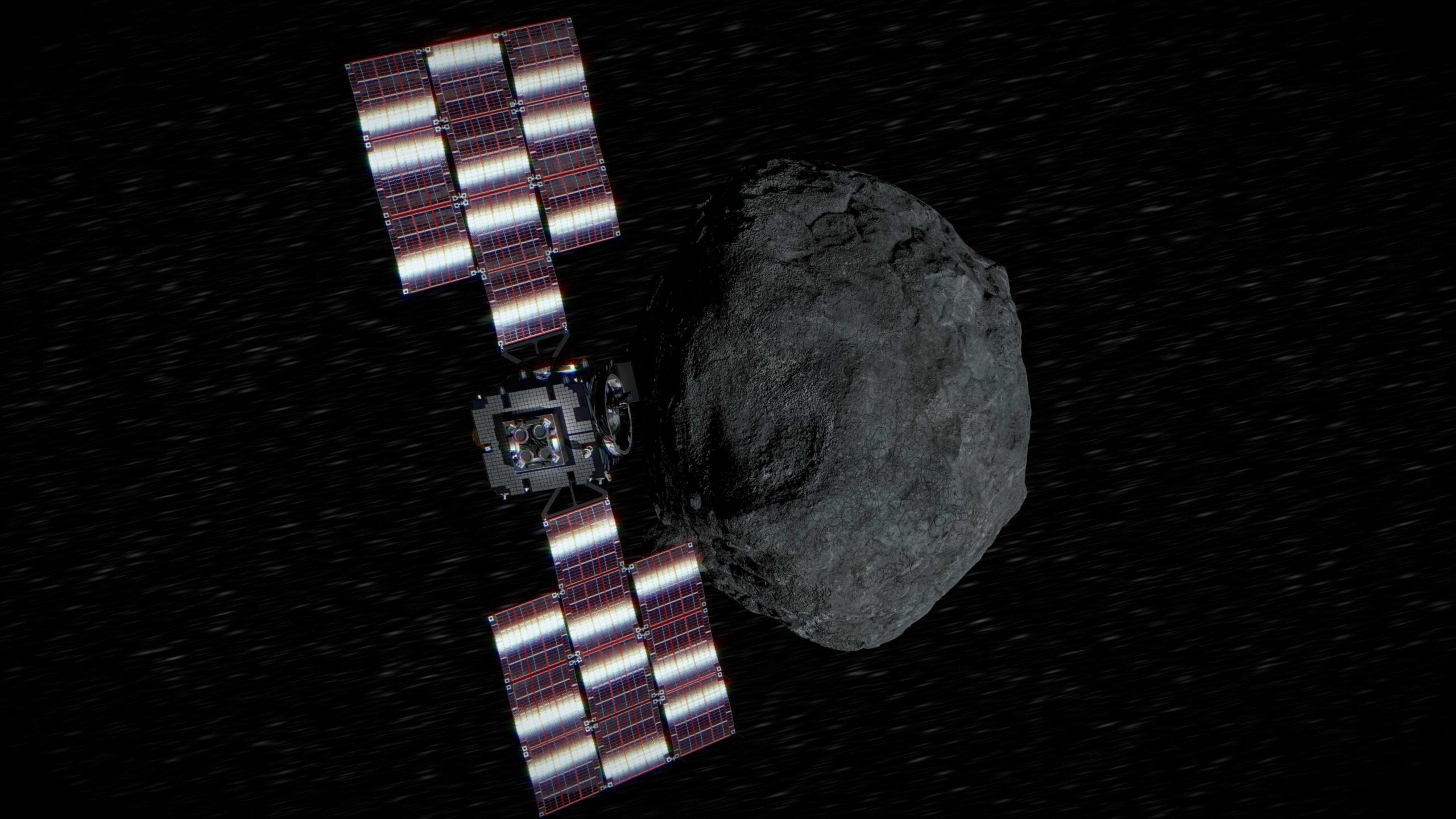DESTINY+とは / What is DESTINY+?
DESTINY+は”Demonstration and Experiment of Space Technology for INterplanetary voYage with Phaethon fLyby and dUst Science”の略で、工学および理学コミュニティによる共同ミッションです。宇宙航空研究開発機構(JAXA)宇宙科学研究所(ISAS)が進める公募型小型計画の2号機として選定され、2028年度の打ち上げを目指して開発中です。
工学面では、将来の深宇宙探査を低コスト・高頻度に行うための工学技術実証を行います。具体的には、電気推進の活用範囲拡大と、先進的なフライバイ技術の獲得を目指します。
理学面では、地球に炭素や有機物を供給する地球飛来ダストの実態解明と、そのダストの一つであるふたご座流星群の母天体である小惑星(3200)Phaethonのフライバイ探査を目指します。
詳しくは、以下の説明をご覧ください。
DESTINY+ stands for “Demonstration and Experiment of Space Technology for INterplanetary voYage with Phaethon fLyby and dUst Science.” It is a collaborative mission by the engineering and science communities. DESTINY+ has been selected as the second spacecraft in the small-class project category led by the Japan Aerospace Exploration Agency’s (JAXA) Institute of Space and Astronautical Science (ISAS). It is currently under development, aiming for a launch in the fiscal year 2028.
From an engineering perspective, DESTINY+ will demonstrate technologies that enable future deep space exploration missions to be conducted at a lower cost and higher frequency. Specifically, it aims to expand the range of applications for electric propulsion and acquire advanced flyby technologies.
From a scientific standpoint, the mission aims to elucidate the nature of interplanetary dust particles that supply carbon and organic matter to Earth. It will also conduct a flyby exploration of the asteroid (3200) Phaethon, which is the parent body of the Geminid meteor shower and one of the sources of such dust particles.
For more details, please refer to the explanation below.
探査機システム /
Spacecraft System
DESTINY+の探査機システムメーカは2020年度に選定され、2024年度の打ち上げ(当初計画)を目指して、約4年間での開発が始まりました。短期間に信頼性の高い探査機を開発するため、新規開発を真に必要な範囲に限定し、既開発品を積極的に活用する方針を定めました。
当初のDESTINY+ミッションプロファイルでは、約2年間の地球周回フェーズと、約4.5年間の惑星間航行フェーズがあり、その両方でイオンエンジンを運転する必要がありました。そこで地球周回衛星である「ひさき」「あらせ」で実績のある小型科学衛星標準バス機器と、惑星間でイオンエンジンを運転した「はやぶさ2」の搭載機器をベースにしました。
一方で地球周回軌道上でイオンエンジンを運転するのは我々にとって初めての経験で、熱設計を始めとする多くの開発課題が生じました。これを含む工学面のハイライトは、下の「工学」のパートで述べています。
2024〜2025年度における計画の見直しにより、地球周回フェーズを省略して、H3ロケットで惑星間空間に直接投入することになりました。ESAの探査機RAMSESとの相乗りで2028年度に打ち上げる計画としています。見直し後の軌道では、2029年4月13日の金曜日(UT)に地球に最接近する昨今話題の小惑星Apophisに最初にフライバイ、その後2030年度にPhaethonにフライバイする計画としています。省略した地球周回フェーズで消費する予定であった燃料は、探査能力の向上として複数の小天体をフライバイするマルチフライバイの実施に活用することにしています。また、惑星周回軌道上でイオンエンジンを運転可能な探査機設計は維持するとともに、イプシロンSロケットによる深宇宙探査に必要な技術としてキックステージの開発も継続する考えです。
The manufacturer for the DESTINY+ spacecraft system was selected in fiscal year 2020, and development began with an approximately four-year timeline targeting a launch in fiscal year 2024 (the original plan). To develop a highly reliable spacecraft in a short period, we adopted a policy of limiting new development to only what was strictly necessary and actively utilizing previously developed components.
The original DESTINY+ mission profile consisted of a two-year Earth orbit phase and a 4.5-year interplanetary cruise phase, both of which required the operation of ion engines. Therefore, the design was based on standard bus components for small scientific satellites, which have a proven track record on the Earth-orbiting satellites “Hisaki” (SPRINT-A) and “Arase” (ERG), combined with instruments from “Hayabusa2,” which successfully operated its ion engines in interplanetary space.
However, operating ion engines in Earth orbit was a new experience for us, presenting many development challenges, particularly in thermal design. The engineering highlights, including this challenge, are detailed in the “Engineering” section below.
Following a plan revision in fiscal years 2024-2025, the Earth orbit phase was omitted. The spacecraft will now be directly injected into interplanetary space by an H3 rocket. The current plan is to launch in fiscal year 2028 as a rideshare with the European Space Agency’s (ESA) RAMSES spacecraft. In the revised trajectory, DESTINY+ will first fly by the asteroid Apophis—a topic of recent interest due to its close approach to Earth on Friday, April 13, 2029 (UT)—and then proceed to fly by Phaethon in fiscal year 2030. The propellant that would have been consumed during the omitted Earth orbit phase will now be used to enhance the mission’s exploration capabilities, potentially enabling a multi-flyby of several small celestial bodies. We will also maintain the spacecraft design that allows for ion engine operation in planetary orbits and continue the development of the kick stage, a technology necessary for future deep space exploration using the Epsilon S rocket.
工学 / Engineering
DESTINY+は、将来の深宇宙探査をより低コスト、高頻度、柔軟に実行するための技術を実証します。
JAXAによる宇宙科学ミッションは、H2AまたはH3ロケットで打ち上げる戦略的中型計画、イプシロンまたはイプシロンSロケットで打ち上げる公募型小型計画、海外ミッションにパートナーとして参加する戦略的海外共同計画、そして小規模計画の4つのカテゴリで推進されています。過去の深宇宙探査機はH2A等の大型ロケットにより打ち上げられてきましたが、実行頻度を高めるには小型のイプシロンSロケットも活用する必要があります。しかしイプシロンSロケットは質量500kg級の探査機を惑星間に送り出す能力を持ちません。そこでDESTINY+は、イプシロンSロケットにキックステージを追加して地球周回長楕円軌道に投入された後、探査機に搭載したμ10イオンエンジンを運転して約1年半にわたり加速して、遠地点高度が月の重力圏に入るまで軌道高度を上げ、約半年にわたって数回の月スイングバイを行うことで、地球の重力を振り切って惑星間空間に旅立つという当初計画でした。
しかし、2023年7月のイプシロンSロケット第2段モータの地上燃焼試験失敗により、能代ロ ケット実験場の真空燃焼試験棟が全損し、真空試験棟復旧スケジュールとキックステージの開発スケジュールに不整合が生じました(真空燃焼試験棟の再建・整備が2027年度になるが、 イプシロンS+キックステージでの打上げ最終期限2027年1月の1年前である2026年1月までに キックステージの性能評価地上燃焼試験が必要)。このような状況下で、ESAが開発しているRAMSESミッションとのH3ロケットによる相乗り打上げに向けた技術的成立性の目途が得られたため、相乗り打上げを前提とした開発に計画変更することとなりました。
見直し後の計画では、H3ロケットにより惑星間空間に直接軌道投入されたDESTINY+は、太陽を公転する軌道でイオンエンジンの噴射により軌道を制御して、小惑星(3200)Phaethonを目指します。Phaethon フライバイのリハーサルとして、相乗り衛星であるRAMSESの探査対象天体であるApophisのフライバイにも挑みます。取得した情報を後続の探査機に共有するなどして、プラネタリーディフェンスの面での貢献も視野に入れています。その後に向かう活動小天体Phaethonが太陽を公転する軌道は離心率と軌道傾斜角がとても大きいので、小惑星と同じ軌道に入って近傍にとどまる「ランデブー探査」を行うことはできず、秒速約36 kmという高速ですれ違う短時間のうちに表面撮像などをする「フライバイ探査」を行います。
DESTINY+はこのミッションを通じて、高速フライバイ探査を実証し、将来の低コスト、高頻度、柔軟な深宇宙探査につなげる計画です。DESTINY+ will demonstrate technologies that will enable future deep space exploration to be more low-cost, frequent, and flexible.
JAXA’s space science missions are promoted in four categories: Strategic Medium-class missions launched by H-IIA or H3 rockets, Competitively-chosen Small-class missions launched by Epsilon or Epsilon S rockets, Strategic International Collaborative missions participating as partners in overseas missions, and small-scale programs. While past deep space probes were launched by large rockets like the H-IIA, utilizing the smaller Epsilon S rocket is necessary to increase the frequency of missions. However, the Epsilon S rocket does not have the capability to send a 500 kg-class spacecraft into interplanetary space on its own. Thus, the original plan for DESTINY+ was to add a kick stage to the Epsilon S rocket to insert the spacecraft into a long elliptical orbit around Earth. From there, it would use its onboard μ10 ion engines to accelerate for about 1.5 years, raising its orbit until the apogee entered the Moon’s gravitational sphere. It would then perform several lunar swing-bys over about six months to escape Earth’s gravity and journey into interplanetary space.
However, the failure of a ground combustion test of the Epsilon S rocket’s second-stage motor in July 2023 resulted in the complete destruction of the vacuum combustion test facility at the Noshiro Rocket Testing Center. This created a mismatch between the facility’s reconstruction schedule and the kick stage development schedule (the facility is expected to be rebuilt in FY2027, but the kick stage’s performance evaluation ground tests needed to be completed by January 2026, one year before the final launch deadline of January 2027 for an Epsilon S + kick stage configuration). Under these circumstances, a technically viable opportunity for a rideshare launch on an H3 rocket with ESA’s RAMSES mission emerged, leading to a change in plans to proceed with the rideshare launch.
In the revised plan, DESTINY+ will be directly injected into an interplanetary trajectory by the H3 rocket. It will then control its course using its ion engines while orbiting the Sun to head for the asteroid (3200) Phaethon. As a rehearsal for the Phaethon flyby, it will also attempt a flyby of Apophis, the target of its rideshare partner, RAMSES. There is also a vision to contribute to planetary defense by sharing the acquired data with subsequent missions. Since the final destination, the active asteroid Phaethon, has a highly eccentric and inclined orbit, a “rendezvous” mission (entering the same orbit to stay nearby) is not feasible. Instead, DESTINY+ will conduct a “flyby” mission, performing surface imaging and other observations during the brief, high-speed encounter at approximately 36 km/s.
Through this mission, DESTINY+ aims to demonstrate high-speed flyby technology, paving the way for future low-cost, frequent, and flexible deep space exploration.
理学 / Science
宇宙から地球に飛来するものといえば、隕石を思い浮かべる方が多いでしょう。しかし、実は年間約4万トンものダストが宇宙から地球に飛来しており、中でも直径100 μm以下の小さなダストは大気圏通過時に加熱の影響を受けにくく、年間約2500トンが地表まで到達すると言われています。これは隕石の約50倍もの量に相当します。そして地表まで到達したダストには炭素や有機物が含まれ、その量は炭素質隕石の数倍以上であることがわかってきています。つまり、宇宙から地球に最も多くの有機物を持ち込む媒体はダストである可能性があるのです。そうして宇宙から地球に持ち込まれた炭素や有機物が地球生命の前駆物質になったという仮説の検証を目指して、近年分野横断的なダスト研究が活発化しています。
高い科学的価値を持つ宇宙からやって来るダストですが、地球の大気に突入すると燃えて発光し、流れ星として私達の目を楽しませてもくれます。毎年12月に見られるふたご座流星群を生み出すダストの供給源(母天体)は、小惑星(3200)Phaethonであると特定されています。Phaethonが過去に放出してきたダストがPhaethonの公転軌道上に残されており(ダストトレイル)、そこに地球が交差するとふたご座流星群として観察されるのです。
「工学」のパートで述べたように、DESTINY+探査機は小惑星Phaethonのフライバイ探査を行います。その際、小惑星近傍に漂うダストをその場分析し、同時に表面をカメラで撮影して地形や物質分布を観測します。加えて、地球周回軌道から惑星間航行までの全ミッションフェーズで、惑星間ダストや星間ダストのその場分析を継続して行い、それらの性質を明らかにします。
これらの観測を行うために、DESTINY+はDESTINY+ Dust Analyzer (DDA)、Telescopic CAmera for Phaethon (TCAP), Multiband CAmera for Phaethon (MCAP)の3台の観測機器を搭載します。DDAはドイツ航空宇宙センター(DLR)のファンディングのもとシュトゥットガルト大学が開発し、千葉工業大学が探査機とのインタフェース調整を担います。TCAPとMCAPは千葉工業大学が開発を主導しています。
詳しくは千葉工業大学惑星探査研究センターのWebサイトをご覧ください。
When thinking about objects that come to Earth from space, many people might imagine meteorites. However, in reality, about 40,000 tons of dust arrive on Earth from space each year. Among this dust, particles smaller than 100 μm in diameter are less affected by heating during atmospheric entry, and it is said that about 2,500 tons reach the Earth’s surface annually. This amount is equivalent to about 50 times that of meteorites. Furthermore, it has been discovered that the dust reaching the Earth’s surface contains carbon and organic matter, and the quantity is several times more than that found in carbonaceous chondrites. In other words, there is a possibility that dust is the medium that brings the most organic matter from space to Earth. In recent years, interdisciplinary research on dust has intensified, aiming to verify the hypothesis that carbon and organic matter brought to Earth from space became the precursor materials for Earth’s life.
While dust from space has high scientific value, it also entertains our eyes as shooting stars when it enters the Earth’s atmosphere and burns up, emitting light. The parent body that supplies the dust responsible for the Geminid meteor shower, which can be observed every December, has been identified as the asteroid (3200) Phaethon. The dust released by Phaethon in the past remains along its orbital path (dust trail), and when the Earth crosses this path, the Geminid meteor shower is observed.
As mentioned in the “Engineering” part, the DESTINY+ spacecraft will conduct a flyby exploration of the asteroid Phaethon. During this flyby, it will perform in-situ analysis of the dust floating near the asteroid while simultaneously capturing images of the surface to observe the terrain and material distribution. Additionally, throughout all mission phases, from Earth orbit to interplanetary travel, DESTINY+ will continuously conduct in-situ analysis of interplanetary and interstellar dust to reveal their properties.
To carry out these observations, DESTINY+ will be equipped with three science instruments: the DESTINY+ Dust Analyzer (DDA), the Telescopic CAmera for Phaethon (TCAP), and the Multiband CAmera for Phaethon (MCAP). The DDA is being developed by the University of Stuttgart under funding from the German Aerospace Center (DLR), with Chiba Institute of Technology responsible for coordinating the interface with the spacecraft. The development of TCAP and MCAP is being led by Chiba Institute of Technology.
For more information, please visit the website of the Planetary Exploration Research Center at Chiba Institute of Technology.
関係機関 / Partners
千葉工業大学
惑星探査研究センター
科学観測機器であるダストアナライザ(DDA)や2台の観測カメラ(TCAP、MCAP)の開発を取りまとめます。
Chiba Institute of Technology
Planetary Exploration Research Center
leads the development of the scientific observation instruments, including the DESTINY+ Dust Analyzer (DDA) and two observation cameras (TCAP and MCAP).
ドイツ航空宇宙センター
ダストアナライザ(DDA)をJAXAに提供します。
German Aerospace Center
provides the DESTINY+ Dust Analayzer (DDA) to JAXA.
シュトゥットガルト大学(ドイツ)
宇宙システム研究所
ダストアナライザ(DDA)の開発を行います。
University of Stuttgart
Institute of Space Systems
develops the DESTINY+ Dust Analyzer (DDA).
名古屋大学
熱制御工学研究グループ
実証機器である可逆展開ラジエータを開発します。
Nagoya University
Thermal Control Engineering Group
develops the retractable thermal panel, which is one of the demonstration equipments.
日本電気株式会社
探査機システム(実証機器であるイオンエンジン、薄膜軽量太陽電池パドルを含む)の開発を担当します。
NEC Corporation
is responsible for the development of the spacecraft system (including the demonstration equipment such as the ion engine system and the lightweight solar array paddles).三菱重工業株式会社
ミッションデータ処理装置(MDP)、イオンエンジンの推進剤供給系(PMU)の開発を担当します。
Mitsubishi Heavy Industries, Ltd.
is responsible for the development of the mission data processor (MDP) and the propellant management unit (PMU) for the ion engine system.
明星電気株式会社
モノクロ望遠カメラ(TCAP)およびマルチバドカメラ(MCAP)の開発を担当します。
MEISEI ELECTRIC CO., LTD.
is responsible for the development of the panchromatic telescopic camera (TCAP) and the multiband camera (MCAP).
株式会社ジェネシア
モノクロ望遠カメラ(TCAP)の光学系 の開発を担当します。
GENESIA Corporation
is responsible for the development of the optics of the panchromatic telescopic camera (TCAP).
株式会社コシナ
マルチバンドカメラ(MCAP)の光学系 の開発を担当します。
COSINA CO., LTD.
is responsible for the development of the optics of the multiband camera (MCAP).
MHIエアロスペースシステムズ株式会社
画像からPhaethonを抽出する搭載ソフトウェアの開発を担当します。
MHI Aero Space Systems, Ltd.
is responsible for the development of the software detecting the Phaethon in the images taken by the TCAP.
日本飛行機株式会社
放射線被曝量を計測するドシメータ (DSM) の開発を担当します。
Nippi Corporation
is responsible for the development of the dosimeter (DSM), which measures radiation dose.
有富設計株式会社
放射線被曝量を計測するドシメータ (DSM) の構造解析を担当します。
Aritomi Design Corporation
is responsible for conducting structural analysis of the dosimeter (DSM), which measures radiation dose.


















